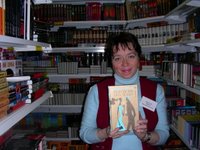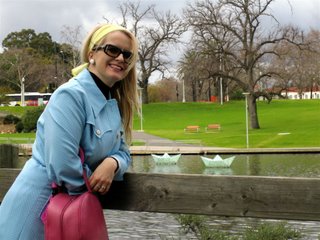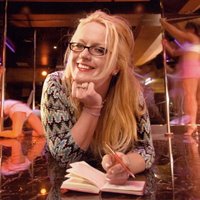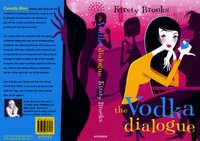 This is an article I wrote back in 2001 regarding SF (Science fiction and Fantasy – Speculative fiction) for the Australian Bookseller and Publisher – the best Australian publishing industry trade magazine around.
This is an article I wrote back in 2001 regarding SF (Science fiction and Fantasy – Speculative fiction) for the Australian Bookseller and Publisher – the best Australian publishing industry trade magazine around.Science fiction is not dead: it just smells funny. The opinion of some booksellers and publishers in Australia is that sales of speculative fiction to mainstream readers has not always been strong, but that fantasy is appealing to an ever-broadening marketplace, increasingly represented by women readers. Science fiction (SF), on the other hand, is successfully maintaining and even expanding its readership, primarily through media spin-offs and military fiction series.
Epic fantasy by Terry Brooks, David Eddings, Robert Jordan, Raymond E. Feist, Australian author Sara Douglass and others is popular because of old fashioned quests, lashings of romance, and historical drama, even if that history is entirely fictional. And as Jonathan Strahan, contributing editor for US-based magazine Locus, notes, the quality of these books is only improving. 'The traditional view of post-Tolkien epic fantasy is that it sells well, but that the books are lousy. That’s beginning to change. Books like Mary Gentle's Ash, China Mieville's Perdido Street Station, Guy Gavriel Kay's Lord of Emperors, and George R.R. Martin's A Song of Ice and Fire series are heralding the appearance of well-written, intelligent "fat fantasy" that is applauded by critics and loved by readers ,' he says.
Strahan goes on to say that, 'While it’s true that cookie cutter fantasy written to fill shopping centre rack space is mostly about escapism, the best fantasy is not. It’s about the lessons a moral person needs to learn to exist in a civilised world'. Escapism is strong drawcard, and, as says PanMacmillan Fiction Publisher Cate Paterson notes, this is a common goal among readers, no matter the genre. 'I think everybody, regardless of age, likes a quest story or someone overcoming the odds. One of the purposes of fiction is escape, to surrender reality, and the reasons people are attracted to fiction are the same, regardless of age.'
'One interesting thing about best selling authors like Robert Jordan is that the books sell extremely well for the first few weeks and then drop right off,' says Dymocks National and International Sales Manager Jeff Higgins. 'What that says to me is that people go in and buy the new Jordan or Raymond E. Feist and then that's it. Those people are kept informed by the Internet and magazines and they just get the books when they come in. I don't see that happen with any other category.'
Paterson suggests that this actually make it easier to sell to genre audiences. 'The appeal of the genre to publishers is that they are interconnected. You do get a real community of fans. (Speculative fiction) is a very connected genre and you can target a lot of people. There is no magazine that general readers will buy, but there is one for genre fiction readers, especially science fiction, fantasy and romance.'
Kaye Wright, Marketing Manager at HarperCollins Australia, publisher of the Voyager science fiction and fantasy imprint, believes that fantasy is a growing market because of its essential avoidance of a technological world, whereas SF celebrates that world. 'I read somewhere that the essential SF question nowadays is no longer "What if?" but "What now?"' Fantasy author and agent with Curtis Brown, Garth Nix agrees: 'Now we are really living in a science fictional world and it's of less interest to us. Fantasy offers a haven from all that.'
If this is really the case, then the marketing decisions that have led to the success of such technologically driven, best-selling escapist titles by authors such as Michael Crichton and Matthew Reilly could be employed to raise the profile of speculative fiction in the mainstream. This has, however, proven to be difficult. 'If we knew what was going to make a Harry Potter we'd just bottle it,' laughs Paterson. Best-sellers are phenomena whose outrageous popularity causes them to outsell other similar titles. They cannot be explained and are therefore, impossible to emulate, but that hasn't stopped people trying. 'I don't know if it's conscious that writers are trying to emulate Harry Potter’, Paterson continues, 'but I do see agents and writers saying, "following the success of Harry Potter, you may see similar things in my manuscript." There is a huge degree of luck involved in publishing, some indefinable thing.'
And while booksellers missed out on profits due to heavy discounting of the Potter books by chain stores, it has helped boost sales of some good quality fiction that has languished on shelves. 'Young adult has a market and people are starting to realise it,' says Galaxy bookstore's Stephanie Tall. 'In America, when everyone was waiting for the next Harry Potter, some booksellers got together to make "While you're waiting for Harry Potter Survival Guide" lists and on it were authors like Philip Pullman and the Narnia series. The sales for those titles skyrocketed and that's got to be good. It got people reading and talking about books.'
Higgins agrees. 'Peer pressure can force people into buying a book and reading it. All age groups were buying Harry Potter and among those were some reluctant reading kids.' But did marketing have much to do with it, or was it, as Stephanie Smith from HarperCollins Australia suggests, a classic case of word of mouth? 'I don't think they put much behind (the first book),' she says. 'But word really just spread. Sometimes there's a bit of magic and certain things just hit a cord with people.'
Combating a prevailing negative attitude toward speculative fiction will possibly require publishers to either accept its limited market, change the way they promote the genre, or increasingly remove genre tags from individual titles. A new title from Pan Macmillan, The Ill-Made Mute by Cecilia Dart-Thornton, is one Paterson hopes will become a successful 'cross-over' novel. Book One in the Bitterbynde Trilogy, The Ill-Made Mute is unusual for the absence of any reference on its cover to fantasy; and like Juliet Marillier’s recent Daughter of the Forest, is clearly aimed at a romance market as well.
One problem with getting mainstream readers to read science fiction is that publishers are reluctant to label current bestsellers as science fiction, probably because they fear harming sales. 'No one's going to tell you that Jurassic Park is an SF novel, but it is,' says Strahan. 'Crichton can write science fiction, sell millions of books, but no one wants to say it's SF because it's right off the radar in terms of sales.'
Depending on what store you go to, sales of literary SF, military SF and media spin-offs appear quite different. 'I try to push everything', says the owner and manager of Slow Glass bookstore in Melbourne, Justin Ackroyd, 'but I do better with the literary side of SF like Ian Banks and Ken McLeod sales wise than the general stuff because we have a reputation for stocking the literary material. I maintain that by keeping things like the complete Philip K. Dick on the shelves.'
'There are science fiction authors who continue to sell strongly,' says Nix. 'Space operas have gone through a resurgence and that is international.' And writers of epic-scale science fiction adventures like Peter Hamilton or Stephen Baxter do sell well. But Jez Newton, the Sydney Dymocks store speculative fiction specialist, believes that military SF sales figures are not indicative of the SF market as a whole. 'It all sells consistently because there is such a huge range,' he says. 'There are about a hundred (SF) books coming out every year but I have no best sellers at all compared to what else is in the shop. Nothing here gets up there, and I sell at least a thousand different titles a week.'
Strahan says the number of SF books published each year is much larger. 'Science fiction is probably selling better than it ever has before.' he says. 'Writers like David Weber or Lois McMaster Bujold have large dedicated audiences, as do Baxter, Hamilton, Scott Card and others. The perception that it doesn’t sell as well as epic fantasy is accurate, but it doesn’t recognise that it’s improving.'
'Unlike general fiction writers, who we promote as Australians, I'm not that sure that any science fiction or fantasy authors who are Australian ever get promoted as Australians,' says Higgins. 'Perhaps it's a hang-up of the media, which can't see that fantasy is more mainstream than it's ever been.' Of Nix, Higgins says: 'He's making more money in the States than he'd ever make here.'
Australian SF author Sean Williams is in a similar situation. With co-writer Shane Dix, he has recently been contracted by Del Rey to write three Star Wars novels, and has faced more mainstream media attention for these than any of his other books. The recognition factor of a known brand outscores on every level.
The mainstream also appears to be more comfortable with SF on the big screen, especially when it involves popular stars, than on the page. SF movies do very well at the box office, even though they are often thirty years behind what is appearing in the publishing world. 'Star Wars, says Newton, 'is nothing more than a pseudo fantasy wrapped up in a science fictional cover and was regarded by most people in literary science fiction as sending SF back twenty years.' Curiously, fantasy-based movies are notoriously poorly received. 'Any fantasy movie you care to mention has not done well.' says Nix. 'I think that might change with The Lord of the Rings, though.' Newton agrees. 'The Lord of the Rings will do better than any movie any time.'
Media spin-offs, such as Star Trek, Buffy the Vampire Slayer and Star Wars, are often regarded with derision from within the SF field, despite their relatively strong sales. The success of these books indicates that SF readers are no different to mainstream audiences. They are looking for something familiar, an area of interest, yet perceptions of speculative fiction continue to be distorted: while the mainstream audience will happily go to a SF movie, the books are a different story.
Some publishers of SF are hoping to change that perception by employing editors and sales staff with familiarity in the field, but outside specialty bookstores, on the other hand, this is rare. 'You really need to read it to be able to sell it,' says Tall, and Strahan agrees. 'Science fiction is a specialty field, and I think publishers in this country have found it difficult to bring themselves up to speed on what makes SF or fantasy work and how it should be published. '
'Fantasy just sells a lot better,' says Smith at HarperCollins. 'It's hard sometimes to get science fiction off the ground. I'll read everything that comes in for the science fiction range and definitely read with a hopeful eye.'
Cover design is one area perhaps deserving reassessment. 'The biggest problem with Sean Williams' first books was that the covers were so dark that they disappeared into the background' says Ackroyd. 'Inheritance by Simon Brown has done okay but in the past he suffered from dark covers too. I liked those covers but the public isn't going to notice them when they scan the shelves. With fantasy the publishers seem to think "Oh yes, that's nice and bright, we'll chose that."'
'Experience shows that if you package a book well, it sells well, says Strahan. 'The Potter books and the Philip Pullman books in the US are handsome, well-made illustrated hardcovers, and they sell. Younger readers are particularly responsive to a magical package. And a bad package can kill a book. One recent award-winning SF title did well in hardcover, but struggled in paperback except in one store. The publisher looked into what had happened. The bookstore owner has wrapped all of his copies in brown paper and written the name of the book on it. Sales went up markedly.'
Other publishers, instead of looking for new ways to market speculative fiction, are increasingly looking to broaden the genre markets. 'Booksellers like categorising things,' Nix says. 'James Bradley is essentially a SF writer, but because he writes literary SF he and his publishers would prefer him to be (marketed) as literary fiction than science fiction. It's an Australian thing. I think there's a bit of a cringe about genre writing.'
Categorising books makes things easier for booksellers, but can limit choices for readers, and ultimately effect sales. 'The upside of genre classification is people in bookshops are directed to the sections where they know they will find something to suit their particular taste' says Paterson. 'The down side is that if a reader merely wants a good read and buys on impulse, they probably won't be looking through the genre shelves. One way round this is to place all the best new fiction, regardless of genre, on the new release shelves before they get relegated to their natural resting place in bookshops.'
Regarding sub genres, Nix explains the enormous hybrid fantasy titles available on the shelves. 'If you had a genre category map that covered everything from pulp fantasy to literary magic realism, you could have pulp fantasy on the X-axis and literary magic realism fantasy on the Y-axis and plot everything from there, but you can argue that SF is just a subset of fantasy. In fact all fiction is fantasy by definition.'
'Within science fiction, the sub genres consist of everything from cyberpunk and military SF to alternate history and feminist utopian fiction,' says Williams. 'SF is a great mixer; you can add it to anything. There is romance SF, thriller SF, crime SF; I've even read western SF. It's almost impossible to name all the varieties.'
And these hybrids are having an increasing effect on the way these books are being marketed. 'Here Be Dragons,' Nix says, 'an historical romance by Sharon Kay Penman, had a cover that looked like a fantasy novel. Fantasy fans would pick it up, see that it was an historical novel and put it back. Fans of historical romance wouldn't even pick it up because it didn't look like something they would read.'
Wright sees attempts to bend genre classification abroad as well as at home. '(Hugo Award-winning SF author) Greg Bear is being pushed into the mainstream in the UK now and I think that is interesting. We had a book by West Australian author Tess Williams which was a crossover novel and we were trying to get that broader audience, which wasn't hard to do.'
The mainstream market often buys speculative fiction when it's marketed to them as non-genre and we're still seeing this with authors such as Tom Clancy, Terry Pratchett and Douglass Adams. It's also worked with more challenging science fiction by the likes of Mary Doria Russell, William Gibson and Doris Lessing. Some of the success publishers and booksellers may find more success with science fiction titles if that cross-over market can be found, or the quality of the marketing and packaging improved. 'Speculative fiction encompasses everything from magic realism to Michael Crichton,' says Williams, 'and the need for that sort of story, whatever it's called, is not going away in a hurry.'
 Dad and a friend restored his Jag over a year or two.
Dad and a friend restored his Jag over a year or two. 
 The car is amazing. When you travel in it, it's like being a rock star because people stop and stare.
The car is amazing. When you travel in it, it's like being a rock star because people stop and stare.  The bonnet is huge and the interior is gorgeous. Even the cigarette lighter says 'Cigar'. It's from a very stylish time. Dad drives around with his pals on the weekend and has a great time. These photos were taken by Stuart, who takes photos of everything... Stuart has a MINI Cooper (see picture below).
The bonnet is huge and the interior is gorgeous. Even the cigarette lighter says 'Cigar'. It's from a very stylish time. Dad drives around with his pals on the weekend and has a great time. These photos were taken by Stuart, who takes photos of everything... Stuart has a MINI Cooper (see picture below). 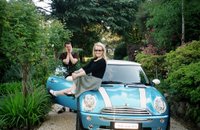 He loves this car. He used to have an old Triumph and still looks at them wistfully on the road, but I know he loves his new car because he washes it so often... In this final photo, I'm sinning against car enthusiasts around the globe, by sitting on the bonnet. I had no idea this was such a heinous crime until I did it, and got horrified looks from both Stuart and my dad, so I had to get a photo taken to prove I was once such a dare-devil. I'm not even allowed to put my feet up on the dash of the Mini Cooper when I'm in the suicide seat but it's worth it because it's such a gorgeous car.
He loves this car. He used to have an old Triumph and still looks at them wistfully on the road, but I know he loves his new car because he washes it so often... In this final photo, I'm sinning against car enthusiasts around the globe, by sitting on the bonnet. I had no idea this was such a heinous crime until I did it, and got horrified looks from both Stuart and my dad, so I had to get a photo taken to prove I was once such a dare-devil. I'm not even allowed to put my feet up on the dash of the Mini Cooper when I'm in the suicide seat but it's worth it because it's such a gorgeous car. 